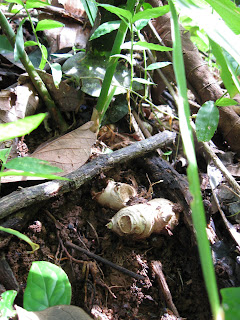

Nutmeg harvest is in full swing - again: the nutmeg seems to fruit every 2-3 months, and sporadically between times. It's a pretty tree, medium sized with shiny leaves in a pleasant shade of green and fruits that look a lot like apricots, and it comes in both genders, one needs to have several trees to ensure a good crop. When the fruits ripen they split in two and fall to the ground revealing the glossy nutmeg seed inside and the incredible red lacy aril: mace. the first time I saw mace I was spellbound by the colour and the beauty, and that such a thing could be hidden away inside a fleshy peachy fruit.
The Nutmeg tree is native to the Spice Islands (Moluccas) and was at one time a fiercely guarded secret by Dutch colonialists who were known to travel to neighboring islands to destroy Nutmeg harvests. Later French and British colonialists exported the trees to Madagascar and the Caribbean. Grenada, the Spice Island of the Caribbean, is famous for its nutmeg: the country's flag is red, yellow and green in representation and one even appears on the left of the flag. Both nutmeg and mace are widely used in cooking imparting a sweet, warm woodsy flavor to drinks, puddings, cakes and savory dishes. Nutmeg has long been supposed to have magical properties, in medieval times it was carried as a talisman to protect against misfortune and illness, and even used to attract admirers! Medicinally it is used to aid digestion.
The mace is removed after harvest and dried separately, the colour fades from a brilliant red to a deep orange amber, and the seed shrinks a little, the nutmeg inside can be heard rattling around. Fresh nutmeg has to be refrigerated, but dry can keep for a very long time.
The fruits have for a long time been left to rot where they fell, becoming compost for the tree, until that is I discovered that they are edible! The flesh is very woody and while subtly flavoured like nutmeg, hardly sweet. I've been making jam and it's very good. It comes out with an apple butter texture and a warm, sweet nutmeg flavour - excellent with ginger scones!
-nutmeg fruits, the fresher the better, but soft is fine too
-brown sugar
-a little nutmeg, cinnamon and ginger (last two are optional)
Wash, peel and cut the fruit finely. Add water to cover and boil until soft, and until 1/3rd of the water has boiled off. Blend to a paste, weigh and add an equal amount of brown sugar. Add some grated nutmeg, about 1/4 teaspoon for every pound of fruit - depending on taste of course, cinnamon and ginger can also be added at this stage. Return to pan and bring to a boil, stirring constantly. Cook until the preserve thickens (a spoon will make a clean trail when drawn across the bottom of the pan) - you can also test for readiness by dipping a spoon and allowing it to cool - if this sets, then your preserve is ready. Bottle in clean, sterilized jars and seal in a hot water bath. Enjoy!

